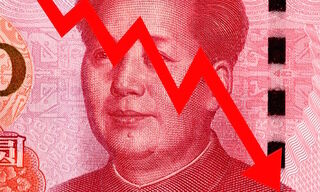“This is not a black and white story. The opportunities lie in the gray area.” Fabiana Fedeli portfolio manager at international asset manager Robeco has just returned from a trip on which she spoke with a number of political, financial and economic experts on the situation in China.
Yes, there are challenges ahead and Fedeli did notice Chinese officials being more nervous and reluctant to be outspoken. The anti-corruption campaign launched by president Xi Jinping has resulted in more limited freedom of expression and opinion, Fedeli thinks. That is the darker side of an approach that also has its advantages. “It does enable the central government to push reforms at local government level more effectively.”
Recently investors have shied away from Chinese stocks due to worries about the country’s future growth. The IMF has lowered growth expectations to just below 7%, but, according to what Fedeli heard on her trip at the moment growth is closer to 5% – 5% and it could fall further unless the Chinese government intervenes with a more comprehensive stimulus program. This implies that the Chinese government will have to rely also on the old means of stimulus, using Fixed Asset Investment (FAI). In the past growth was triggered by FAI, and this has created overcapacity in some areas. We have all heard the stories of ‘roads to nowhere’ and ‘ghost towns’. However, in recent years the country has been in search of a more sustainable growth path de-emphazing FAIs and promoting services and consumption, says Fedeli.
‘There is still significant demand for buildings in Tier 1 and 2 cities’
In itself, 5% growth is not a bad thing – Western countries can only dream of such figures – and it would be fine if that 5% growth was the result of less FAI-driven growth with a higher contribution from services and consumption. However, manufacturing has dropped faster than the government had hoped for, and although growth in services and consumption has been healthy, it has not risen as much as was hoped for. More FAI is the obvious way to stimulate growth, but it will mean taking a step back in terms of economic transition.
“More stimulus is not per se a bad thing. We live in an era of government stimulus around the globe. Just look at the Federal Reserve, the ECB and the Bank of Japan. Although until recently, China has been in more of a tightening mode. But the key question is: where are the FAI made?,” Fedeli says. She is optimistic on this point though. “Xi seems to have enough control to determine where the assets go to. There is still a need for metro lines, links between city hubs, hospitals and schools.”
Lessons learned
That does sound a bit optimistic for anyone who has seen images of ghost cities all over China. But this is exactly the area where Xi can now make a difference, Fedeli thinks. “In recent years money has not been effectively channeled by local governments, who sold land to developers wherever they could, triggering a real estate bubble in some cities. But there is significant demand for buildings in Tier 1 and 2 cities and even in the centers of Tier 3 cities. Location and facilities are key, things that were overlooked in the big boom after 2009. But lessons have been learned.”
After speaking to many experts on China, what does Fedeli consider to be the biggest common misunderstanding on the country’s economy? “The first thing is definitely the idea that China has no need for any further FAI because it has over built and over invested. This is not necessarily true for all regions. The transportation in and between cities leaves room for improvement and there are still opportunities in real estate as well.” The second misunderstanding, according to Fedeli, is the idea that the potential of urbanization has run its course.
‘In recent years money has not been effectively channeled by local governments’
“There is still a sea of migrants from the countryside who work in the cities, but have no residential rights there. The result is that they don’t build a life with their families in the cities, so they don’t spend in the cities. These people are city dwellers on loan from the countryside.” But things are expected to change here too, with the Hukou (house registration) reforms. These new reforms will give these immigrants residential rights in the cities where they work. “We are talking about around 100 million people and there could be as much as CNY 4 tln (approx. USD 630 bln) involved in the related reforms, equaling the total economic stimulus in 2009.”
Force to be reckoned with
Going back to the old ways is not without risk, though. ”The main risk is how the FAI will be implemented”, Fedeli believes. “In the old days local governments inflated their balance sheets in order to finance stimulus programs. But today this cannot be done to the same extent.” That leaves two other options. “The central government can increase local government tax revenues to create sufficient cash flow to finance the reforms, or alleviate some of the debt burden on local governments' balance sheets. They may do a combination of the two. And then it’s a matter of not just selling land to anyone, as was the case after 2009.”
At the moment Fedeli thinks the risk-reward balance looks fine – the rewards are greater than the risks. “China is still a country with huge consumption potential. It is still a force to be reckoned with. In 20 years from now, it will be the biggest economy in the world, on a PPP basis. There’s no way we can ignore that and the country offers investors an excellent pool of companies to choose from.” Does recent volatility on the stock market not scare Fedeli? “Yes, Chinese stocks may be more vulnerable to market volatility – that comes with the territory. It could take another 10 years or more before China is a sophisticated market with a more stable pool of domestic institutional investors and less retail-driven market volatility”.
But recent volatility does not mean that the sentiment is right. This may create great opportunities, Fedeli thinks. “During times of panic the correlation tends to go to 1, but that gives investors the chance to pick up really solid stocks at a cheaper price.” And in the longer run, the opening up of the Chinese financial markets will offer great opportunities, she thinks.
“They are still in their infancy and still a long way from being in line with the size of the economy. Of course there’s been a lot of distortion, we have seen a real estate bubble and the boom and bust of onshore stocks, but that’s mainly due to a lack of alternatives for Chinese investors,” says Fedeli. That will change in the future. Fedeli believes that the Chinese government will open the markets further, even if it leads to capital outflows. “The challenge is to do so gradually. That, of course, is easier in theory than in practice.”
A tale of two Chinas
For now the main thing is to watch the central government’s reforms and stimulus plans. “We need to monitor that very closely,” Fedeli says. “Once we understand what they are going to do and how, we can adjust our stock selection accordingly.” As said, the opportunities lie in the gray area of a story that is often sketched in black and white. “We see two Chinas: the new and sustainable one, and the bad one ridden with excess capacity. And then there is the gray area – an area where stock selection is even more crucial, but one that can still deliver alpha.”




















